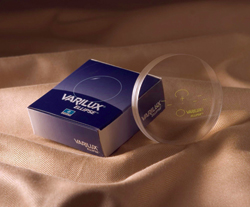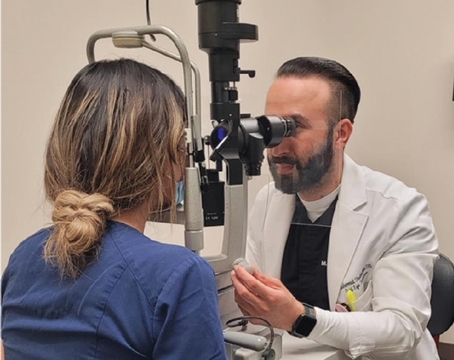With the continued popularity of smaller frames and B measurements, you're sure to have plenty of demand for short-corridor progressive lenses in your dispensary. But success with this relatively new lens category isn't just a matter of finding a lens that fits in a tiny frame. I've found that short-corridor lenses succeed the best if you follow a few tried-and-true rules.
1. Stick with what you, and the patient, know.
It's no surprise that this lens category has ballooned from just five or six choices a few years ago to more than 20 different brands in 2005. Many of the newer designs work very well and will please a number of patients. However, I've found that it's better to work with the progressive lens brands you know best. When patients have been wearing a longer-corridor progressive successfully for some time, it is wise to keep them in the same brand or one that is similar in design, regardless of your preferences as a dispenser.

That's not saying you shouldn't try a new short corridor lens design. I have started using the Essilor Varilux Ellipse, Carl Zeiss Gradal Brevity and Hoya Summit CD lenses for my short-corridor options. The Summit CD has become one of my favorites. But I have dispensed a lot of Essilor and Hoya lenses over the years, so my learning curve with these brands isn't as steep.
Short-corridor lenses made by major manufacturers are now available in virtually any material. Whenever you can, use Trivex for your low to moderate prescription ranges (+3 to -3.75 D); for prescriptions needing high-index materials, anti-reflective coatings are a must.
2. Your best candidate is the emerging presbyope with low cylinder.
These patients usually are the ones gravitating to the fashionable frames, and fortunately, they have low add powers (under 1.75 D). Early presbyopes have minimal intermediate needs, so they don't experience the "intermediate gap" and have less of a need for an intermediate range. Those with cylinder under 1.5 D will do best, as higher cylinders will decrease the usable area of the lens, which may already be limited by the short corridor.
This doesn't mean advanced presbyopes can't do well. Some patients with higher add powers feel uncomfortable gazing far down into their frame to find the reading power, and have developed a habit of looking through the intermediate area when doing near work. Put this patient in a short corridor, and she will be able to "get into" the add power sooner and more easily.
Which patients might have problems? Those who do long-term, extensive work at near or intermediate distances, such as someone working on a computer all day. It's tough to fit all the optics they need into the short corridor.
3. Present the limitations up front.
I explain that short-corridor lenses allow you to get into the reading area more quickly, but something is always compromised. Typically it is the intermediate area. Demo lenses are a great tool. Just make up a pair of PALs with plano at distance, and 1.75 add. The patients can see the reading and intermediate areas for themselves.
It is very important to explain to patients that one pair of eyeglasses cannot meet every visual need. I market the short-corridor lenses as everyday eyeglasses, for general use. For any specific use, I will recommend a second pair that addresses the patient's extreme visual situations. This opens an opportunity to talk about the benefits of specialty lenses such as "computer" lenses. (I sell them frequently).
4. Avoid "butterflies," and fit carefully.
You will need a frame with a B dimension of no less than 24, and consider this at the nasal portion of the frame. A butterfly style frame that is narrow at the nose and widens at the temples will have the B measurement at the deepest portion of the frame near the temple. Take the fitting height for the PAL and add 10 mm for the distance area, and that will give you the B measurement you will need in the frame.
Also, avoid a frame in which you can't put pantoscopic tilt. For best results from a progressive, you need 10 to 12 degrees of pantoscopic tilt. A few other fitting tips:
• Go for minimal vertex distance; fit as close as you can without rubbing the eyelashes (This gives the widest field of view).
• Before taking monocular pupillary distances and fitting heights, always pre-adjust the frame to exactly how the patient wants to wear it.
• Watch the patients' posture. Pay attention to how they carry themselves. Do they hold their chin up or down? Is this a tall or short person? All of this will affect the fitting height.
5. Take control of dispensing.
When it's time to dispense eyewear with short corridor lenses (or any progressive lens), take control of the situation. Don't let the patient just plop the glasses on her face and look around wildly. Why? Because the first impression is the most lasting. If the patient looks through those lenses and her vision is blurred, chances are, she's going to be coming back with continuous complaints.
• With the fitting cross still on the lenses, place the eyewear on the patient yourself to keep control.
• Make sure the frame is adjusted with the fitting cross where you intended and place the eyewear in the proper position.
• First have the patient look straight ahead and from side to side to check his distance and peripheral vision.
• Next place a reading card in front of the patient, and have him raise and lower his chin. Point out how the near objects get clearer as he gazes downward.
• While he is focusing on the reading card, tell the patient to hold his head still, move the reading card off to the left and right. Let the patient see the limits of the reading area and explain "always point your nose where you're looking."
Ms. Ostrom is the program director for the opticianry department at J. Sargeant Reynolds Community College. Contact her at KOstrom@jsr.vccs.edu.






